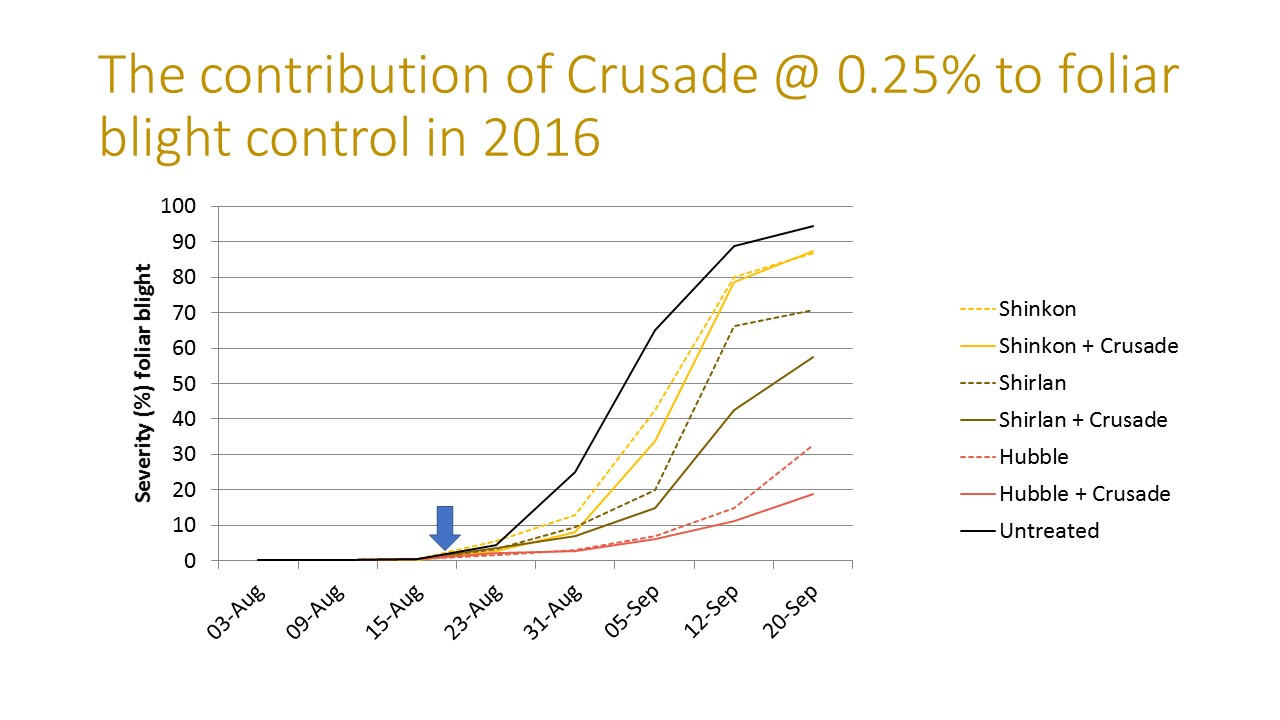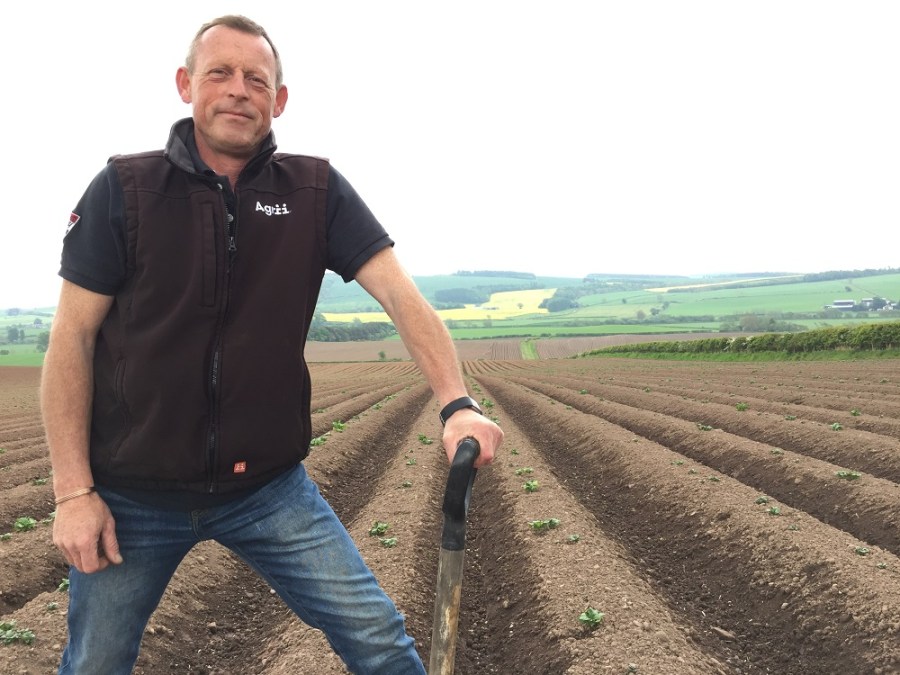
Keeping late blight out of potato crops is a season-long campaign for growers. An innovation in anti-drift technology is proving to be a ‘knight in shining armour’ by boosting the effect of fungicides. CPM reveals more about this exciting discovery.
Both strong and weak fungicide actives can have weak spots due to poor coverage.
By Lucy de la Pasture
Late blight has a habit of finding its way into potato crops eventually. Frequent application of fungicides delays the inevitable and, with luck, limits the epidemic to below economically damaging thresholds. But what if blight fungicides could work better without applying any more active ingredient?
Interagro’s Emma Ralph believes they’ve discovered the Holy Grail and developed a specialist drift retardant that achieves just this, with independent trials demonstrating a 19% average increase in levels of blight control.
“We wanted to develop a product that takes into account the practical problems growers and agronomists face in the field, especially now blight programmes are typically on seven-day spray intervals.
More flexibility
“Our research started with the objective of finding an innovation that would give potato growers more flexibility in their blight programmes and enhance a range of different active ingredients,” she explains.
SRUC specialist in blight epidemiology and control, Dr Ruairidh Bain, agrees flexibility is a key element of modern blight programmes, particularly since Phytophthora infestans population change has made blight control more difficult.
“Variation in risk dictates fungicide programme flexibility and this risk varies between seasons and within the season. Where there’s a risk of poorly-timed fungicide applications, fungicide input needs to be boosted,” he says, pointing out that the mean resistance rating (1 to 9) of the UK crop is now lower than before the mid-2000s.
After three years of independent trials conducted by Ruairidh Bain at SRUC’s Auchincruive Estate in South Ayrshire, Interagro is launching Crusade, a specialist drift retardant, this summer. But Crusade is proving to be more than just a drift retardant, it’s actually helping blight fungicides work more effectively, according to Emma Ralph.
So how is it doing this? The answer to the question is that Crusade helps delivery of the fungicide in a number of ways, she explains.
“Its anti-drift properties reduce the number of fines which creates a more consolidated spray pattern. This concentrates the delivery of spray droplets so that more hit the target leaves and stems, giving better coverage.
“Crusade contains a blend of specialist oils which are lipophilic, creating a creeping ability across the leaf. This means there’s a spreading effect which continues for a few hours after application until the whole leaf surface is covered, taking the fungicide with it,” she continues.
Ruairidh Bain explains that spray coverage is one of the factors that needs to be better to protect the crop against the new, more aggressive blight genotypes, 13_A2 and 6_A1.
“Everything else being equal, the new genotypes of P. infestans tend to produce sporangia earlier and in greater numbers than most of the displaced genotypes. Weak spots in haulm protection are more likely to be found out, and both strong and weak fungicide actives can have weak spots due to poor coverage.
“Where coverage isn’t optimal then there tends to be a scattered blight infection across the crop rather than in foci. Such scattered infection moves the risk of tuber blight to the whole crop, rather than in defined areas,” he explains.
Ruairidh Bain has been working with Crusade in SRUC’s potato blight trials since 2014 and confirms he has seen an improvement in efficacy of blight fungicides where the drift retardant has been included.
“The unusual thing about Crusade is there seems to be an improvement in blight control with a wide range of different active ingredients, whereas most adjuvants generally only have a positive effect with one or a limited number of specific products,” he comments.
The trials results at SRUC have looked very positive in seasons with quite different blight epidemics. In 2014, Crusade was included in the stable canopy trials conducted on the notoriously foliar blight-susceptible variety, King Edward (rated 3).
In the trial, rapid canopy protection was provided with an application of Curzate M (cymoxanil+ mancozeb), followed by three applications of Consento (fenamidone + propamocarb hydrochloride). Crusade was included from stable canopy on 7 Aug (when recorded blight was 0.075%) and applied with Percos (ametoctradin+ dimethomorph) continuously until desiccation, a total of eight applications at an average of eight-day intervals over the season.
The contribution of Crusade to foliar blight control in 2016

Source: SRUC stable canopy trials
Epidemic flared up
“The 2014 trial was at a second site and there was a long build up to the blight epidemic, which flared up in the last three weeks of the season. In the plots where Crusade was included, there was a spectacular effect,” he says.
At this stage in the development of the new product, Ruairidh Bain highlights that they were using Crusade at a rate of 0.5% v/v. The label rate has now been refined to 0.25% v/v and this was the rate used in all subsequent testing at SRUC, he clarifies.
In 2016, the fungicide programme structure was similar. Rapid canopy protection was a programme of Revus (mandipropamid), two applications of Ranman Top (cyazofamid) followed by an application of Revus then Ranman Top. Curzate M was tank mixed with the first spray and straight cymoxanil with the other four.
Application six was the first test spray to include Crusade, with 0.38% blight recorded in the crop at stable canopy on 15 Aug. Six applications of Crusade plus different blight fungicides were made, at an average spray interval of 7.2 days.
“In 2016, the blight epidemic took off half-way through the season, so much earlier than in 2014. The disease pressure was already high when the Crusade started to be added to fungicide treatments at stable canopy, but there were still improvements in control with all the fungicides it was tested with,” he says.
Within SRUC trials, Crusade significantly improved blight control with Hubble (dimethomorph+ fluazinam), Percos, Shinkon (amisulbrom) and Shirlan (fluazinam).
Results showed a significant improvement in foliar blight control when used with the above and in another trial with Electis (mancozeb + zoxamide) and Presidium (dimethomorph + zoxamide). Formulation of the fungicide doesn’t appear to matter, with both SC and WG formulations tested.
Ruairidh Bain believes the development of the new product is an exciting one, not least because of its potential role in providing a valuable ICM option because of its ability to improve blight control without increasing the dose of active ingredient applied to the crop.
Further in-field studies in commercial crops have been carried out that back up the trends shown in SRUC research, explains Emma Ralph, including work by Eurofins, Agrii and a range of fungicide manufacturers, including BASF.
“The field observations suggest that Crusade cuts drying times for partner fungicides, which brings real practical advantages, namely enabling growers to continue spraying in showery conditions,” she explains.
“The trials and extensive use on-farm in 2016 also demonstrated impeccable crop safety, even with Shirlan, known to cause phytotoxicity when mixed with mineral oil.
“With current blight strains producing a lot more sporangia than older strains, 100% coverage with fungicide is vital to prevent blight. Growers understand the principles of effective blight control – the right fungicide choice, at sufficient dose, applied at tight intervals – but we all know that sometimes things don’t go to plan and spray programmes are compromised,” she adds.
“Of key benefit to growers is the flexibility Crusade provides. As well as the wide tank mix flexibility and low dose rate, there is no maximum growth stage cut-off and Crusade can be used throughout the blight fungicide programme,” she notes.
Jim McNair, agronomist with Agrii in the Scottish Borders, had his first experience with Crusade last season and is in no doubt of its credentials as a drift retardant.
“Feedback from our Agrii contract-spraying operators and other growers was very positive. They rated Crusade as user-friendly and better than current industry standards for drift reduction. From a practical perspective, the number of sprayable hours in the day was increased where the product was used, as well as providing increased rainfastness.”
The most striking thing about Crusade was the appearance of the crop after application, he reports.
“The leaves of the crop had a distinct sheen, almost as if it had been painted with varnish. But while it was quick-drying and certainly weatherproofing the fungicide on the leaf, the research coming out of SRUC suggesting improvements in fungicide efficacy was interesting,” he adds.
Commercial use
“Our results in commercial use were very much in line with the SRUC trials, with treated crops showing excellent green leaf retention and good fungicide efficacy across a range of different blight products.
“The product seems to provide a protective layer to help keep blight out but it’s the increased uptake of product that’s of interest from an agronomic perspective,” says Jim McNair.
Last season he added Crusade to his blight programmes during rapid canopy expansion, which was when it first became available. This year he intends to include Crusade earlier in some situations.
Ruairidh Bain explains that during this phase of rapid haulm growth, fungicide coverage is stretched. Early in rapid canopy development, leaf resistance is also low.
Jim McNair believes this is a good reason to add Crusade at rapid canopy, when improvements in spray coverage and uptake will help improve the efficacy of products with translaminar and systemic activity.
His growers already using Crusade are likely to stick with it, not because of the ‘armour of faith’ but the science that backs it up. In SRUC trials, yields were improved by an average of 2.2t/ha, which at potato prices of £200/t, equates to £440/ha improvement in margins at an application cost of just a few £/ha.
BOX: Research Briefing
To help growers get the best out of technology used in the field, manufacturers continue to invest in R&D at every level, from the lab to extensive field trials. CPM Research Briefings provide not only the findings of recent research, but also an insight into the technology, to ensure a full understanding of how to optimise its use.
CPM would like to thank Interagro for sponsoring this Research Briefing and for providing privileged access to staff and material used to help bring it together.
Interagro is a pioneering, R&D-focused company that develops a wide range of innovative adjuvants to optimise the performance of agricultural and horticultural inputs.
Interagro has over 100 products in 30 international markets, and are the experts in the specialist spray adjuvant business throughout the UK, EU, Eastern Europe and North Africa.




